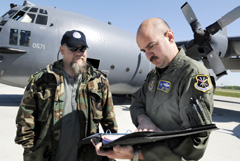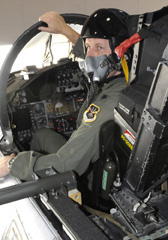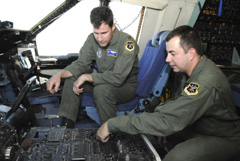
| Members of the 339th
Flight Test Squadron Ensure Aircraft are Fit to Fly |
|||
|
4/25/2008 - ROBINS AIR FORCE BASE, GA -- For members of the 339th Flight Test Squadron, their below the radar existence means a job well done. The mission of the group is to certify aircraft as worthy to return to the fight. The squadron is responsible for conducting flight tests on the C-130 Hercules, the C-5 Galaxy and F-15 Eagle after program depot maintenance is completed at the Warner Robins Air Logistics Center. Every time the engineers and pilots fly and return safely after an uneventful flight, the sound of success rings in their ears. "It's a good thing people don't know about us, because it means we are doing a good job and not having a lot of incidents," said Chief Master Sgt. Harry Smith, chief flight engineer. The aircrew members, which are both active-guard reservists and traditional reservists, are trained on a specific aircraft. The differences within each aircraft are significant as there are 24 variations of the C-130, four of the C-5 and five of the F-15. "It is challenging for the pilots and engineers who fly them to be proficient," said Maj. Jeremy Mickelson, a C-130 pilot. He explained some aircraft appear exactly as they did when they rolled off the assembly line, while other aircraft have been modified, adding items such as extra refueling pods and terrain-following radar to help them perform their varied missions. The members of the squadron are all aware how important their role is to the success of the warfighter. "These airplanes are going from here back to their home unit and almost immediately back to the war on terror," said Lt. Col. Fritz Heck, commander of the 339th Flight Test Squadron. "When they need it to work, we want it to work, whether it's evading a threat or getting it to a target we want them to know they can count on it." All of the aircraft the unit flies go through months of program depot maintenance before the pilots of the 339th FTS put them back in the air for the first time. "We wouldn't be here if the maintainers weren't doing their job," said Master Sgt. Tony Valente, a C-130 flight engineer. "There are a lot of systems, we can't look at. We rely on them to check so we can fly it," said Master Sgt. Patrick Cioffi, C-5 flight engineer. Eddie Minter, a crew chief for the C-130 flight test with the 402nd Maintenance Wing, said one of the many advantages of the relationship between the maintainers and the members of the squadron is the ability to draw from all the varied experience available from both the aircrew members and the maintainers. "They rely on us and we rely on them," Mr. Minter said. Colonel Heck said the big picture is the maintenance mission of the WR-ALC. "We only see those airplanes for two weeks at a time, and there are 1,000s of man hours that go into the aircraft to get them ready to fly," Colonel Heck said. The maintainers, engineers and flyers all maintain a relationship that fosters open communication to ensure the aircraft are deemed airworthy as quickly and efficiently as possible. "We are the last mechanics to work on the aircraft before the flight. We have to get it right for them," said Frank Castrillo, C-5 functional test mechanic. "It's a complex aircraft. Getting them to all work in unison takes a lot of hard work." However, keeping the test pilots safe and prepared for any emergency that could arise is also a top priority for the squadron and the maintainers they work with. "We've got to have a rapport with these pilots because they trust their lives with us," said George Reid, an F-15 flight chief. Members of the aircrew flight equipment team are responsible for providing the equipment needed during an emergency for training the aircrew in areas such as water and land survival. The team also ensures the flight engineers and pilots are safe during the test flight by supplying the aircrew with "Dixie cups" also known as oxygen masks, parachutes and survival vests for each flight. The team loads the equipment before takeoff and inspects the life protection equipment for damage after each flight. "These pilots fly these planes faster and harder than they'll be flown in their lifetime," Mr. Reid said. Colonel Heck said for many people, the only thing they've heard from the squadron is a sonic boom. He said the sonic boom is the most dangerous part of the test flight for the F-15 because pilots can't eject at those speeds. "We do it at about 40,000 feet and only do it if we have to," Colonel Heck said. No matter how dangerous the sonic boom is, it is a required part of the flight test. Along with their flight test responsibilities, the squadron also picks up and delivers aircraft including battle damaged aircraft to locations where they are needed or can be repaired. The squadron is also considered the subject matter experts for the plane's systems and many times their phone rings when Airmen around the world are having mechanical malfunctions and need to know how to fly or land safely. Source: USAF Robins AFB Press Release by Amanda Creel |
| |


